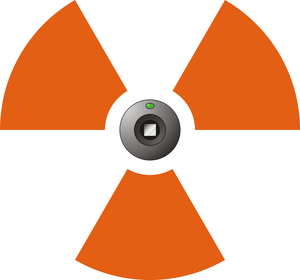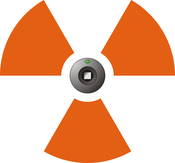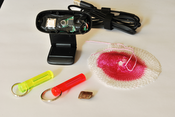Information
- Publication Type: Poster
- Workgroup(s)/Project(s):
- Date: August 2012
- Publisher: ACM
- Location: Los Angeles, CA
- Address: New York, NY, USA
- ISBN: 978-1-4503-1682-8
- Event: ACM SIGGRAPH 2012
- Editor: Dan Wexler
- Booktitle: ACM SIGGRAPH 2012 Posters
- Conference date: 5. August 2012 – 9. August 2012
- Pages: 40:1 – 40:1
- Keywords: radioactivity, webcam, measurement
Abstract
Measuring radioactivity is almost exclusively a professional task in the realms of science, industry and defense, but recent events spur the interest in low-cost consumer detection devices. We show that by using image processing techniques, a current, only slightly modified, off-the-shelf HD webcam can be used to measure alpha, beta as well as gamma radiation. In contrast to dedicated measurement devices such as Geiger counters, our framework can classify the type of radiation and can differentiate between various kinds of radioactive materials.By optically insulating the camera's imaging sensor, recordings at extreme exposure and gain values are possible, and the partly very faint signals detectable. The camera is set to the longest exposure time possible and to a very high gain to detect even faint signals. During measurements, GPU assisted real-time image processing of the direct video feed is used to treat the remaining noise by tracking the noise spectrum per pixel, incorporating not only spatial but also temporal variations due to temperature changes and spontaneous emissions. A confidence value per pixel based on event probabilities is calculated to identify potentially hit pixels. Finally, we use morphological clustering to group pixels into particle impact events and analyze their energies.
Our approach results in a simple device that can be operated on any computer and costs only $20-30, an order of magnitude cheaper than entry-level nuclear radiation detectors.
Additional Files and Images
Additional images and videos
Additional files
 Handout:
An illustrated how-to guide to convert an HD webcam into a radioactivity detector. Used as handout at the conference demonstration.
Handout:
An illustrated how-to guide to convert an HD webcam into a radioactivity detector. Used as handout at the conference demonstration.
 Measurement_images:
Images from the measurements of alpha, beta, gamma and neutron radiation.
Measurement_images:
Images from the measurements of alpha, beta, gamma and neutron radiation.
 Poster:
The conference poster.
Poster:
The conference poster.
Weblinks
No further information available.BibTeX
@misc{Auzinger_2012_GeigerCam,
title = "GeigerCam: Measuring Radioactivity with Webcams",
author = "Thomas Auzinger and Ralf Habel and Andreas Musilek and
Dieter Hainz and Michael Wimmer",
year = "2012",
abstract = "Measuring radioactivity is almost exclusively a professional
task in the realms of science, industry and defense, but
recent events spur the interest in low-cost consumer
detection devices. We show that by using image processing
techniques, a current, only slightly modified, off-the-shelf
HD webcam can be used to measure alpha, beta as well as
gamma radiation. In contrast to dedicated measurement
devices such as Geiger counters, our framework can classify
the type of radiation and can differentiate between various
kinds of radioactive materials. By optically insulating the
camera's imaging sensor, recordings at extreme exposure and
gain values are possible, and the partly very faint signals
detectable. The camera is set to the longest exposure time
possible and to a very high gain to detect even faint
signals. During measurements, GPU assisted real-time image
processing of the direct video feed is used to treat the
remaining noise by tracking the noise spectrum per pixel,
incorporating not only spatial but also temporal variations
due to temperature changes and spontaneous emissions. A
confidence value per pixel based on event probabilities is
calculated to identify potentially hit pixels. Finally, we
use morphological clustering to group pixels into particle
impact events and analyze their energies. Our approach
results in a simple device that can be operated on any
computer and costs only $20-30, an order of magnitude
cheaper than entry-level nuclear radiation detectors.",
month = aug,
publisher = "ACM",
location = "Los Angeles, CA",
address = "New York, NY, USA",
isbn = "978-1-4503-1682-8",
event = "ACM SIGGRAPH 2012",
editor = "Dan Wexler",
booktitle = "ACM SIGGRAPH 2012 Posters",
Conference date = "Poster presented at ACM SIGGRAPH 2012
(2012-08-05--2012-08-09)",
note = "40:1--40:1",
pages = "40:1 – 40:1",
keywords = "radioactivity, webcam, measurement",
URL = "https://www.cg.tuwien.ac.at/research/publications/2012/Auzinger_2012_GeigerCam/",
}


 Poster
Poster
